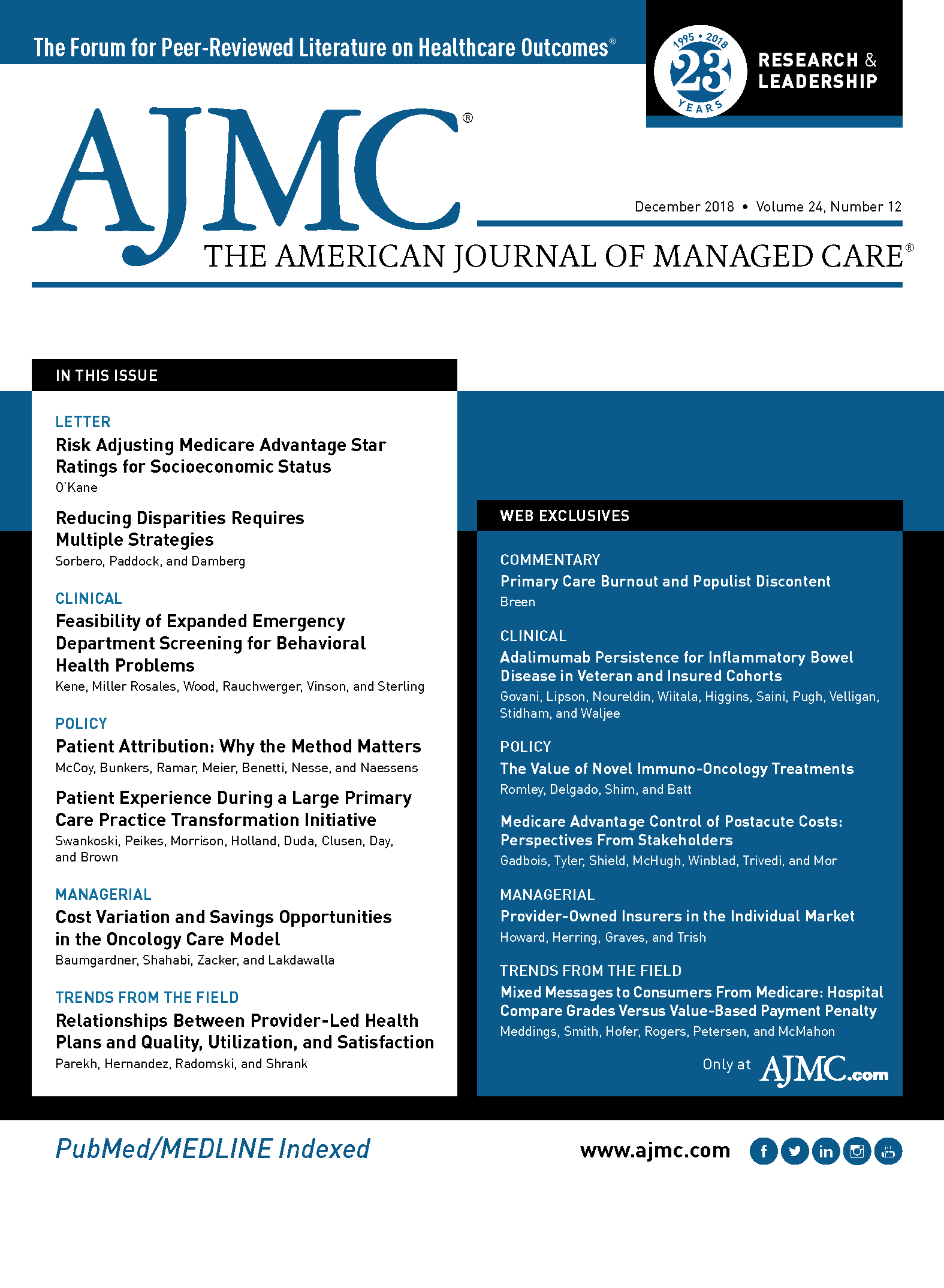- Center on Health Equity & Access
- Clinical
- Health Care Cost
- Health Care Delivery
- Insurance
- Policy
- Technology
- Value-Based Care
Reducing Disparities Requires Multiple Strategies
Disparities in care are a complex issue requiring multiple strategies to solve, including approaches to improve the measurement of quality and reporting stratified performance estimates.
Am J Manag Care. 2018;24(12):577Addressing disparities in care is a critical issue that requires multiple strategies to solve. We concur with Ms O’Kane that sharing best practices among providers and across healthcare organizations and stratifying results to spotlight differences are important actions.1 We applaud the steps that the National Committee for Quality Assurance is taking to report Healthcare Effectiveness Data and Information Set scores stratified by socioeconomic status (SES). We also agree that additional payments to providers who treat a disproportionate share of low-SES patients could help them make needed investments to support the delivery of high-quality care.
In prior work, we proposed that incentive programs consider adjusting incentive payments to mitigate the negative effects of redistributions of payments across providers with disparate patient populations.2 This approach categorizes providers based on a set of predefined patient or provider characteristics, such as percentage of low-income patients, and then sets the average incentive payout to be the same across provider categories. We found that this approach nearly doubled payments to disadvantaged physician organizations and greatly reduced payment differentials across physician organizations according to patients’ income, race/ethnicity, and region.
The National Academy of Medicine (NAM) identified 4 categories of strategies to account for social risk factors in public reporting and payment systems.3 Two of these categories include strategies mentioned by Ms O’Kane: public reporting stratified by patient or provider characteristics, and direct adjustment of payments through risk adjustment of payment formulas or stratification of payment benchmarks.
However, another category of strategies identified by NAM includes risk adjustment of performance measure scores for within-provider differences associated with social risk factors. Receipt of appropriate care is not entirely under the control of providers when performance is connected with social risk and its consequences.4 Failure to account for within-provider differences in performance associated with social risk factors that are beyond provider control risks disincentivizing providers to treat patients with social risk factors and mismeasuring care quality.5 The Categorical Adjustment Index (CAI) adjusts for within-plan disparities. As such, the CAI is not confounded by quality differences across plans.6 The focus on within-provider disparities is similar to current adjustments for differences in patient clinical complexity across providers, such as for patient-reported experience measures collected by Consumer Assessment of Healthcare Providers and Systems surveys.7
As noted in the NAM report, “The fact that some units (eg, providers) do well with socially at-risk populations does not imply that it is equally easy to do so on average, and such population differences may also affect the relationship between provider quality and observed provider scores. The standard for taking such factors into account should not be that it is impossible to provide optimal care, but that it is more difficult on average.”3
Strategies to improve the measurement of quality can go hand-in-hand with other strategies, such as reporting stratified performance estimates, to address disparities in value-based purchasing programs.Author Affiliations: RAND Corporation, Pittsburgh, PA (MES), and Santa Monica, CA (SMP, CLD).
Source of Funding: None; original research performed under contract for CMS.
Author Disclosures: The authors report no relationship or financial interest with any entity that would pose a conflict of interest with the subject matter of this article.
Authorship Information: Concept and design (MES, SMP, CLD); acquisition of data (SMP, CLD); analysis and interpretation of data (MES, SMP); drafting of the manuscript (MES, SMP, CLD); critical revision of the manuscript for important intellectual content (MES, SMP); statistical analysis (MES, SMP); obtaining funding (SMP, CLD); administrative, technical, or logistic support (MES, SMP, CLD); and supervision (MES).
Address Correspondence to: Melony E. Sorbero, PhD, MS, MPH, RAND Corporation, 4570 Fifth Ave, Ste 600, Pittsburgh, PA 15213. Email: msorbero@rand.org.REFERENCES
1. O'Kane ME. Risk adjusting Medicare Advantage star ratings for socioeconomic status. Am J Manag Care. 2018;24(12):566.
2. Damberg CL, Elliott MN, Ewing BA. Pay-for-performance schemes that use patient and provider categories would reduce payment disparities. Health Aff (Millwood). 2015;34(1):134-142. doi: 10.1377/hlthaff.2014.0386.
3. National Academies of Sciences, Engineering, and Medicine. Accounting for Social Risk Factors in Medicare Payment: Criteria, Factors and Methods. Washington, DC: The National Academies Press; 2016.
4. HHS, Office of the Assistant Secretary for Planning and Evaluation. Report to Congress: Social Risk Factors and Performance Under Medicare’s Value-Based Purchasing Programs. Washington, DC: HHS, Office of the Assistant Secretary for Planning and Evaluation; 2016. aspe.hhs.gov/pdf-report/report-congress-social-risk-factors-and-performance-under-medicares-value-based-purchasing-programs. Accessed July 20, 2017.
5. National Quality Forum. Risk Adjustment for Socioeconomic Status or Other Sociodemographic Factors.Washington, DC: National Quality Forum; 2014. qualityforum.org/Publications/2014/08/Risk_Adjustment_for_Socioeconomic_Status_or_Other_Sociodemographic_Factors.aspx. Accessed October 31, 2018.
6. Sorbero ME, Paddock SM, Damberg CL, et al. Adjusting Medicare Advantage star ratings for socioeconomic status and disability. Am J Manag Care. 2018;24(9):294-300.
7. About CAHPS. Agency for Healthcare Research and Quality website. ahrq.gov/cahps/about-cahps/index.html. Updated April 2018. Accessed October 31, 2018.

Blister Packs May Help Solve Medication Adherence Challenges and Lower Health Care Costs
June 10th 2025Julia Lucaci, PharmD, MS, of Becton, Dickinson and Company, discusses the benefits of blister packaging for chronic medications, advocating for payer incentives to boost medication adherence and improve health outcomes.
Listen
Trends in Hospital Pricing for Vulnerable Emergency Department Users, 2021-2023
December 4th 2025Self-pay emergency department prices rose significantly from 2021 to 2023, especially at for-profit and system-affiliated hospitals, highlighting growing affordability challenges for uninsured and underinsured patients.
Read More

